Wooden countertop in the bathroom: description of types, tips for choosing and care

The appearance of the bathroom will noticeably change if a wooden countertop is introduced into the interior. Wood is organic with any cladding material and is a necessary element for some styles.
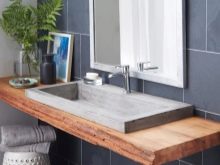
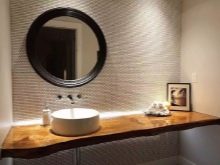
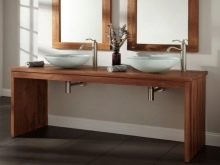
Advantages and disadvantages
A wooden countertop in bathrooms is not often found; many consider this material incompatible with conditions of high humidity. But no one is surprised by a bathhouse or a sauna in the form of a log house, although the conditions in them are much more destructive for wood. With proper handling and care, a wooden countertop can last for several generations. In addition to durability, it has other advantages.
- Environmentally friendly. The natural combination of water and wood is so organic that you can feel their positive energy.
- Original... Deciding to install a wooden countertop, we get a unique piece of furniture for the bathroom, which is unlikely to be found among friends and acquaintances.
- Beautiful and stylish. It's hard to doubt the splendor of natural wood. It suits all styles, but is especially important for the country style (country, chalet, Provence, rustic), for classicism, historical, ethnic and ecological styles.
- Easy to handle. Wood is a malleable material and is easy to work with. If you have certain carpentry skills, you can prepare and install the countertop yourself.
- Varied... The drawing of each tree is never repeated. The color palette of wood products has many shades.
- Compatible. The tree is not only suitable as a companion to stone, tiles, glass and other materials, it will ennoble them with its expensive, presentable look. The thicker the wood, the more expensive and delightful the countertop looks.


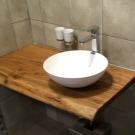
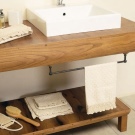
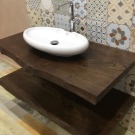
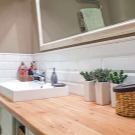
But the tree also has disadvantages.
- The most famous is hydrophobicity. The soft and porous structure easily absorbs moisture, which destroys the material and exposes it to rot. Over time, the countertop becomes a haven for fungi and bacteria. For the same reason, traces of creams, shampoos, hair dyes remain on the surface.
- Moisture and high temperatures will deform poorly processed products.
- Wood can be scratched, chipped and otherwise destructive.
- The countertop will have to be looked after regularly. For people who are too busy, this kind of material will not work.
- The cost of wood is quite high. This is especially true for solid wood and exotic varieties.
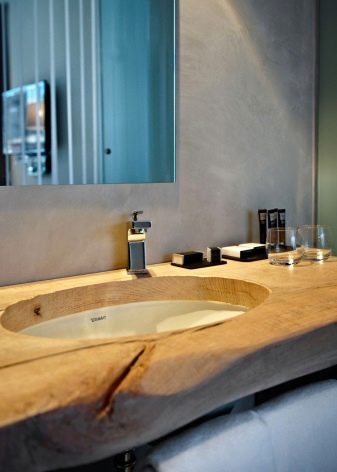
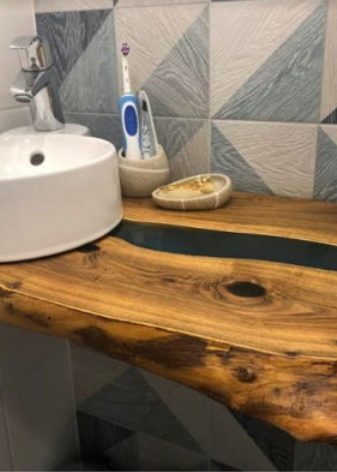
With proper processing and care, there will be no trouble with the countertop, in addition, the tree lends itself well to restoration, you just need to remove the damaged layer, treat it with an antifungal agent and cover it with a water-repellent layer - varnish or paint.
Design overview
The size of the countertop depends on the parameters of the place chosen for it, products can be of different lengths, depths and thicknesses, they can have standard and unusual shapes, but structurally they are divided into only three types.
Built-in sink
This design is a tabletop canvas with a cutout corresponding to the plumbing, a sink is installed in it. The sink is located below the level of the countertop, it is less noticeable, and it does not have to be expensive and spectacular, in this case the emphasis is on the beauty of wood.
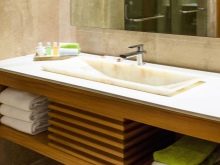
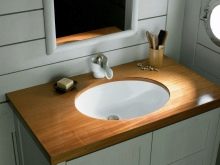
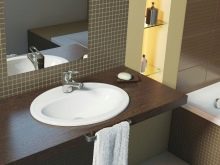
Countertop washbasin
In this version, a small hole is made in the countertop, only for draining, and the sink itself is installed on the surface. Expensive snow-white plumbing with smooth geometric lines contrasts well with dark tree species.
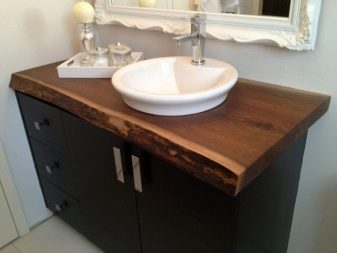
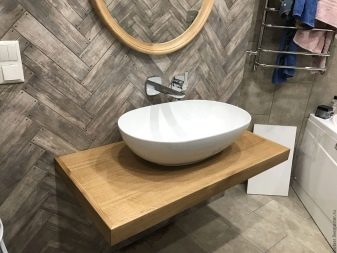

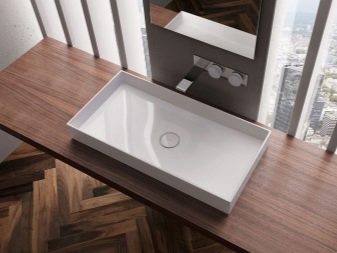
Monolithic
This is the most unusual and expensive option when the countertop itself acts as a sink. A monolithic structure can be made from a solid and very hard piece of wood. Inside it, a bowl for washing and a drainage hole are cut out, communications are connected to it. Dense and well-prepared wood does not rot for many years in contact with water. After antimicrobial and antifungal treatment, it is covered with a special varnish with the addition of mother-of-pearl.
The wood acquires an expressive appearance, the pattern of structural fibers plays beautifully in any kind of lighting. The monolithic countertop will need constant maintenance, and if done, it will last a surprisingly long time.
For the countertop, sometimes not solid wood is used, but several large bars, which are glued together under pressure on special presses.
It is important here to connect the drawing in such a way that it looks as effective as possible on the surface.


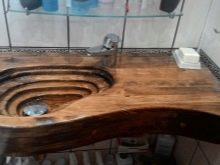
Materials (edit)
Wooden countertops include not only products made from furniture boards or solid wood, they also use chipboard material. A description of the characteristics of each product will allow you to study them and make the right choice.
Solid wood
The most expensive and beautiful option for creating a countertop is made from a solid wood. For the bathroom, it is better to choose dense types of wood. Our ancestors built their ships from durable, low-porous varieties of trees, and they easily came into contact with water for decades. A table top made of solid larch or oak will perfectly cope with its duties.
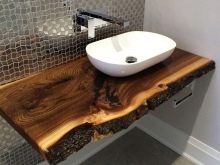
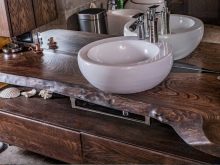
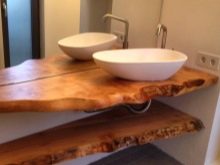
Chipboard
The most inappropriate material for bathrooms, but available to the majority of the population. Sawdust and coarse shavings are glued together with resins and pressed using pressure. The toxicity of the adhesive is exacerbated by the hot fumes found in the bathroom.The surface of the countertop is laminated to protect it from moisture, but if the layer is broken, the dampness quickly deforms and destroys the chipboard. The service life of such a product is no more than five years.
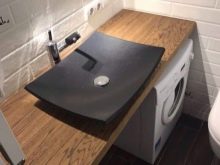
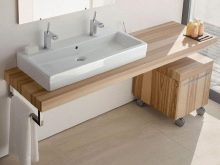
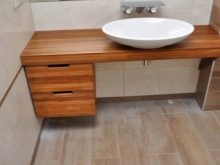
MDF
In terms of price-quality ratio, it is the most popular material. It is somewhat more expensive than chipboard, but much more reliable in operation. It is made from fine shavings, impregnated with paraffin and pressed. The product is durable, non-toxic, environmentally friendly. The material lends itself to embossing, which allows you to decorate the surface of the furniture. The table top is laminated to keep it out of contact with water. With good care, the product will last up to 10 years.

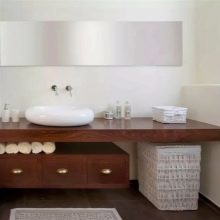
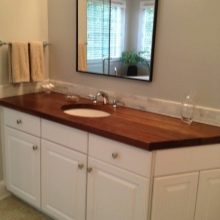
Slabs
If you make a cut of a large tree (longitudinal or transverse) at the level of the thickness of the countertop, this will be a slab. For slab products, valuable varieties of trees with a unique pattern and color are chosen. To preserve the natural beauty, the edges are left untreated. Further, the wood is protected from fungi with special impregnations and covered with layers of varnish.
Slab countertops are among the most unusual and expensive products.
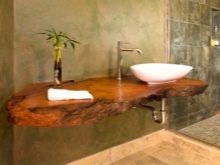
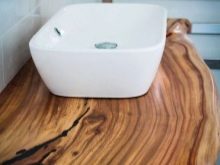
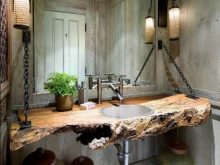
Furniture board
Natural polished boards are glued and pressed, thus a furniture board is obtained, which is subsequently used in the manufacture of products. To create the material, hard and medium types of wood are used - ash, beech, oak, less often pine.
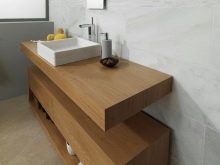


Selection Tips
A tree of unequal density has a different cost. Before making a choice, you should be aware that dense varieties have low porosity, so they almost impervious to moisture and do not swell, as is usually the case with softer wood. The choice depends on the budgetary possibilities of each particular family. You can divide tree species into the following categories:
- dense - ebony, jatoba, sucupira, walnut, merabu, oak, larch, olive, maple, cedar, wenge;
- medium density - bamboo, ash, teak, pear, hornbeam, elm, beech;
- low density - birch, alder, chestnut.
Oak is especially popular among domestic varieties. There are two ways that oak can be waterproofed.
- Stained, that is, by prolonged soaking, when tannins begin to work and give the product special strength.
- Burntwhen the strength of wood is obtained with the help of fire. This technique was invented by the Japanese, but improved by Dutch shipbuilders. After firing, the burnt layer is removed with stiff brushes, revealing a beautiful and durable material.
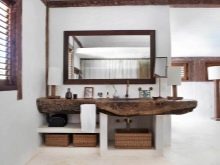
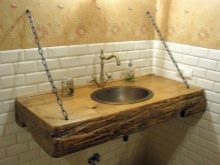
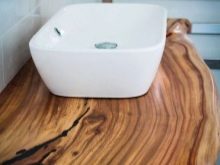
Beech has an average fiber density. To make them waterproof, the surface of the wood is covered with wax.
The dense texture of larch works well for bathroom countertops. It can be embossed, brushed and other interesting technologies.
The walnut has a beautiful texture and several varieties of rich colors. It belongs to dense materials that are used for elite countertops.
Despite the fact that teak is considered a medium-dense wood, it contains rubber compounds in its composition, which best affects the presence of water-repellent properties. The teak top has a beautiful honey tint.
In addition to the breed, when choosing a material for a countertop, you need to pay attention to its primary processing. The wood must be dry, even, free of knots and cracks. If the product is made from raw material, it may deform during drying.
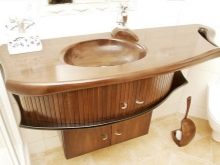
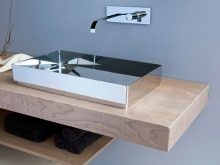
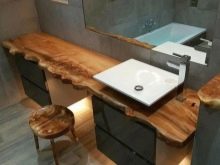
How to care?
It is possible to preserve the performance qualities of wood for a longer time if it is correctly selected, installed, and looked after.
- In order for the damp atmosphere in the bathroom to become familiar to the countertop, it needs to lie down in these conditions for several weeks before installation.
- Any moisture on the wood surface should be removed immediately.
- Do not use abrasive wood care products.
- To keep as much of the countertop surface as possible, it is better to choose an overhead sink, since only a small drain hole is required to install it.
- The lacquered model lasts 10-15 years, then it should be renewed.
- A product covered with an oil layer requires more careful maintenance. Four times a year, it must be soaked with fresh formulations of oils to maintain its pleasant appearance.

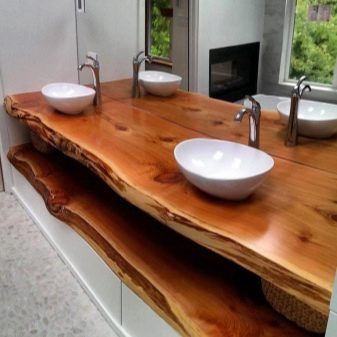
The wooden countertop in the bathroom is spectacular and unusual, it creates an atmosphere of home comfort. The product will last a long time if you care for it with love.
For information on how to make a hidden installation of a wooden countertop, see the next video.








